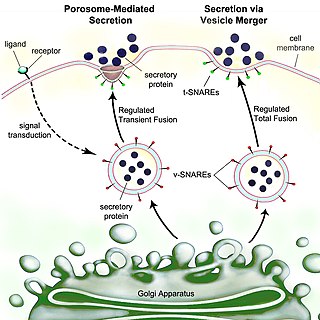
Secretion is the movement of material from one point to another, such as a secreted chemical substance from a cell or gland. In contrast, excretion is the removal of certain substances or waste products from a cell or organism. The classical mechanism of cell secretion is via secretory portals at the plasma membrane called porosomes. Porosomes are permanent cup-shaped lipoprotein structures embedded in the cell membrane, where secretory vesicles transiently dock and fuse to release intra-vesicular contents from the cell.

Yersinia pseudotuberculosis is a Gram-negative bacterium that causes Far East scarlet-like fever in humans, who occasionally get infected zoonotically, most often through the food-borne route. Animals are also infected by Y. pseudotuberculosis. The bacterium is urease positive.
Translocase is a general term for a protein that assists in moving another molecule, usually across a cell membrane. These enzymes catalyze the movement of ions or molecules across membranes or their separation within membranes. The reaction is designated as a transfer from “side 1” to “side 2” because the designations “in” and “out”, which had previously been used, can be ambiguous. Translocases are the most common secretion system in Gram positive bacteria.
In enzymology, a 2-oxoglutarate carboxylase (EC 6.4.1.7) is an enzyme that catalyzes the chemical reaction
In enzymology, a beta-glucan-transporting ATPase (EC 3.6.3.42) is an enzyme that catalyzes the chemical reaction
In enzymology, a capsular-polysaccharide-transporting ATPase (EC 7.6.2.2) is an enzyme that catalyzes the chemical reaction
In enzymology, a Fe3+-transporting ATPase (EC 7.2.2.7) is an enzyme that catalyzes the chemical reaction
In enzymology, an iron-chelate-transporting ATPase (EC 3.6.3.34) is an enzyme that catalyzes the chemical reaction
In enzymology, a lipopolysaccharide-transporting ATPase (EC 3.6.3.39) is an enzyme that catalyzes the chemical reaction
In enzymology, a maltose-transporting ATPase (EC 3.6.3.19) is an enzyme that catalyzes the chemical reaction
In enzymology, a manganese-transporting ATPase (EC 3.6.3.35) is an enzyme that catalyzes the chemical reaction
In enzymology, a molybdate-transporting ATPase (EC 3.6.3.29) is an enzyme that catalyzes the chemical reaction
In enzymology, a Na+-exporting ATPase (EC 3.6.3.7) is an enzyme that catalyzes the chemical reaction
In enzymology, an oligopeptide-transporting ATPase (EC 3.6.3.23) is an enzyme that catalyzes the chemical reaction
In enzymology, an oligosaccharide-transporting ATPase (EC 3.6.3.18) is an enzyme that catalyzes the chemical reaction
In enzymology, a peptide-transporting ATPase (EC 3.6.3.43) is an enzyme that catalyzes the chemical reaction
In enzymology, a phosphate-transporting ATPase (EC 3.6.3.27) is an enzyme that catalyzes the chemical reaction
In enzymology, a teichoic-acid-transporting ATPase (EC 3.6.3.40) is an enzyme that catalyzes the chemical reaction
In enzymology, a Zn2+-exporting ATPase (EC 3.6.3.5) is an enzyme that catalyzes the chemical reaction
Autoinducers are signaling molecules that are produced in response to changes in cell-population density. As the density of quorum sensing bacterial cells increases so does the concentration of the autoinducer. Detection of signal molecules by bacteria acts as stimulation which leads to altered gene expression once the minimal threshold is reached. Quorum sensing is a phenomenon that allows both Gram-negative and Gram-positive bacteria to sense one another and to regulate a wide variety of physiological activities. Such activities include symbiosis, virulence, motility, antibiotic production, and biofilm formation. Autoinducers come in a number of different forms depending on the species, but the effect that they have is similar in many cases. Autoinducers allow bacteria to communicate both within and between different species. This communication alters gene expression and allows bacteria to mount coordinated responses to their environments, in a manner that is comparable to behavior and signaling in higher organisms. Not surprisingly, it has been suggested that quorum sensing may have been an important evolutionary milestone that ultimately gave rise to multicellular life forms.


